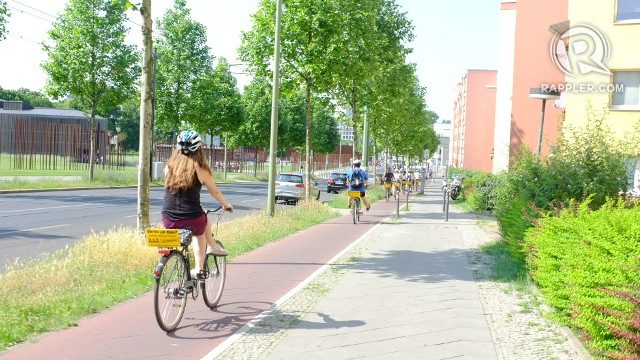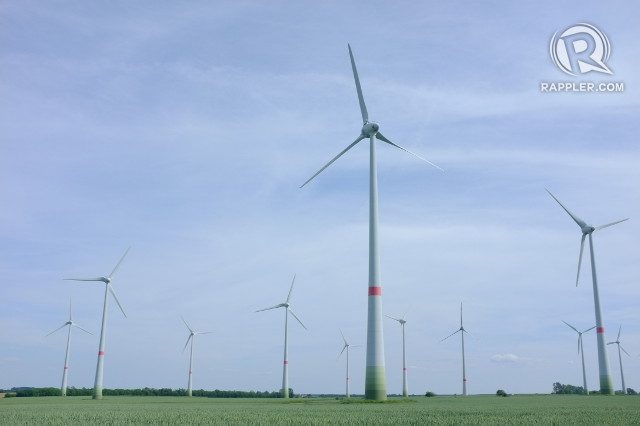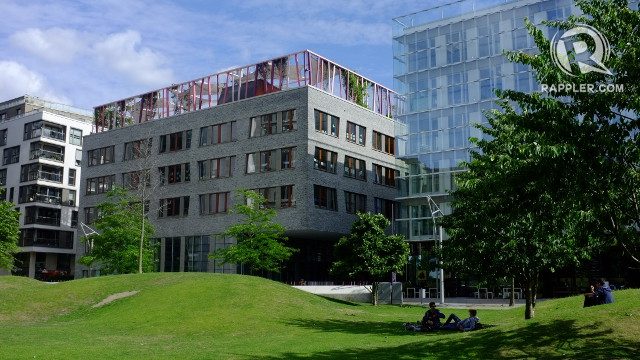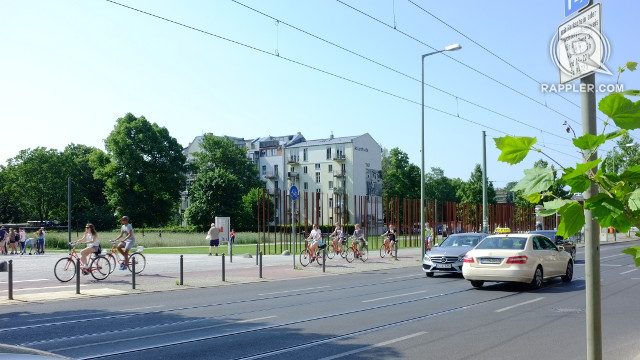SUMMARY
This is AI generated summarization, which may have errors. For context, always refer to the full article.

HAMBURG, Germany – There’s no doubt about it, every country in the world needs to drastically cut carbon emissions sooner than later.
No matter how small a country’s emissions, such as the Philippines’ (only 0.31% of global emissions came from the country from 1999 to 2010), those emissions need to disappear fast if the world is to meet its target of keeping the rise in global temperature well below 2°C.
It’s not going to be easy. The Philippine population is growing (we’re currently at 102 million) and with that comes rising demand for transportation, power, food, buildings, goods, and services – things which tend to emit a lot of carbon.
All countries in the world, especially developing countries, face the challenge of growing their economies in a way that does not spew too much carbon into the atmosphere. But some countries are faring better than others, whether it be from having more resources or stronger political will from their leaders.
Germany, with its battlecry of Energiewende or “energy transition,” is one of those countries championing renewable energy.
The northern European country aims to reduce its carbon emissions by 40% by 2030 compared to 1990 levels and even an ambitious 95% reduction by 2050.
At the moment, around 33% of its power supply comes from renewable energy (for the Philippines, it’s around 28%, according to the Department of Energy). But it continues to rely heavily on coal. In fact, it’s the world’s biggest lignite coal burner.
But because of energy grids and power storage technologies connected to numerous solar and wind power generators, its use of renewable energy can go as high as 96% on sunny or windy days.
There are even days when Germany has so much renewable energy that some wind turbines need to be shut down so as not to overload the system, said Karsten Smid of Greenpeace Germany.
This plus a liberalized energy sector means Germans pay relatively low sums for their electricity use. In fact, Germans who produce their own energy through solar panels or wind turbines in their homes even get paid for contributing to the country’s power supply.
It’s easy to dismiss the German model as incomparable to the Philippine context because it is one of the richest countries in the world and is landlocked (and can thus easily export or import energy from its neighbors if something goes wrong with its grid, something the Philippine archipelago won’t be able to do cheaply).
But Germany faces challenges similar to the Philippines’ with its powerful coal and automobile industries that continue to lobby against renewable energy.
Both countries have renewable energy laws that are considered landmarks in their respective regions, and implement a feed-in-tariff scheme to encourage private sector investments in renewables.
Both economies face growing populations and high emissions from the transportation sector.
Taking into consideration these differences and similarities, what can the Philippines learn from Germany?
1. Improve business environment for renewable energy
Philippine energy officials, when asked why coal still dominates the country’s power supply, always say it’s because the energy sector is investor-driven. The government can’t determine where investors will choose to sink in their capital. Because coal plants are perceived to be cheaper and simpler to construct, most investors choose to invest in coal and there’s nothing government can do about it.
But governments can create a business environment that makes renewables a sexier investment than coal. In Germany, such a process is already underway. The government is so vocal about supporting renewables that fossil fuel companies are creating counterpart companies that will be focused solely on green energy.

E.ON, Germany’s largest power utility company which had been focused on fossil fuels, now has a counterpart company just for renewable energy which is now one of the world’s leading operators of offshore wind farms. They have also invested in solar energy.
The German government has pulled this off by subsidizing renewables to the tune of €16 billion a year (consumers are charged a renewable energy tax in their electricity bills) and ensuring “grid priority” to renewables – meaning the national grid must take in their electricity first. This ensures profits for renewable energy companies and losses for fossil fuel companies.
With the staggering drop in the cost of solar and wind power technology, aided by manufacturing giant China, renewable energy investments in Germany are looking much more robust – an unfortunate reality for companies still focused on fossil fuels.
This state of affairs has prompted the financial officer of German power utility RWE to say in a The Economist article, “Conventional power generation, quite frankly, as a business unit, is fighting for its economic survival.”
Things are not as rosy for the Philippines, with a majority of the population mired in poverty and thus unable to pay more taxes for renewable energy subsidies.
For this reason, coal plants will continue being cheaper to build than renewable energy plants.
“We cannot do away with fossil fuels, at least not in our lifetime. That’s why we still have to accommodate coal,” said Mario Marasigan, the renewable energy management bureau chief of the energy department.
But there are still ways the government can work around this. It can prioritize subsidies for renewables when spending development aid. Or it can impose taxes on a sector of society that can afford such taxes, say high-emissions industries.
It can also address complaints of delays in the processing of applications for new renewable energy ventures, delays which tend to turn off investors.
2. Implement a carbon pricing scheme
Making polluters pay is the basic premise of a carbon pricing scheme. Nowadays, coal plants and other greenhouse-gas-emitting establishments are polluting for free in the Philippines.
In the European Union, such a scheme, called the emissions trading system, is already in place. In this system, polluting industries are given a maximum amount of emissions, making it a limited commodity. Permission to emit is distributed or auctioned off by government.
For companies to emit more (in times of high demand, for example), they need to purchase “emission rights.” Conversely, if the company is able to reduce its emissions, meaning not use up the entirety of its emission rights, it can sell its surplus emission rights to other companies.
While a trading system works best in a region (like the EU or Southeast Asia), the Philippines, on its own, can at least impose a carbon price on its emitting industries.
China, a country suffering from poor air quality because of its polluting factories, intends to do just this.
“Carbon pricing is a good idea for the Philippines because it’s a good way to capture wealth. Government can have a source of finance,” said Dr Daniel Klingenfeld from the Potsdam Institute for Climate Impact Research in Germany.
In the Philippines, imposing such fees will take immense political will, especially as fossil fuel company owners are highly influential in national politics.
3. Provide incentives for vehicles that emit less
While a bill providing incentives for the use of electric vehicles is languishing in the Philippine Congress, such incentives are already up and running in Germany.
Germans who buy cheap or mid-range electric cars (around €60,000) enjoy rebates of €4,000 to €5,000. They are also exempt from vehicle tax and get to use bus lanes for free. To top it off, the German government has promised to finance the construction of electric car charging infrastructure which means charging stations may soon be as ubiquitous there as gas stations are in the Philippines.
Youthful lawmakers like Senator Paolo Benigno “Bam” Aquino IV and Las Piñas Representative Mark Villar championed an Alternative Fuel Vehicles Bill in the Senate and House Representatives, respectively. It’s a promising piece of legislation which, if enacted, will give electric car owners priority in the issuance of plate numbers, exemption from number coding, and free parking spaces in new establishments.
Unfortunately, the bill never reached the finish line.
In Germany, incentives have also been given for more fuel-efficient cars. An energy rating (A+ for the most fuel-efficient car) is the premise for the entire scheme.
Some cities have established “Environmental Zones,” entire areas where only cars of a certain energy rating are allowed to enter. Usually, these are areas near schools. But in some cities, like Hamburg, such a proposal was met with opposition from the business sector.
Can the 17th Congress finally pass the Alternative Fuel Vehicles Bill? With Villar, one of the bill’s authors, as the new Public Works and Highways secretary, will there be moves in the executive department to implement something similar even without legislation? How open are local governments to implementing their version of environmental zones?
4. Reward energy-saving buildings
Visit a typical office in Germany on a bright summer’s day and you’ll find all the lights turned off and the large windows open. In a Metro Manila office, especially one bereft of windows, the lights are on the entire day, aside from the all-important airconditioning to ward off the tropical heat.
Energy efficiency is a big deal for building owners in Germany. The federal government has devoted more than a million euros for grants and loans to enable homeowners and building owners to renovate their buildings to make them consume less energy. The move saves them some 6 million tons of CO2 per year according to the environment ministry.

The scheme cushions costly energy requirements for buildings. It’s also backed by local ordinances. In the city-state of Hamburg, for example, the local government provides free consultancies to establishments to make them more energy-efficient.
Energy-saving technologies come at a cost. Hamburg residents often complain of high rental fees, even if the Hamburg government imposes a limit on how much landlords can charge after the renovation.
But the argument is that the energy saved from following the requirements is reflected in lower electricity bills, ultimately a boon to both the consumer and the climate.
The Philippines has made good steps in this direction. The Department of Public Works and Highways has finalized its Green Building Code to be imposed upon all new structures of a certain size, depending on the type of establishment. The challenge now is implementation.
5. Make life easier for commuters, pedestrians
Places where cars are the primary form of transportation no doubt emit more carbon. Unsurprisingly, in car-obsessed Philippines, the transportation sector is the 3rd biggest source of carbon emissions.
In major German cities like Berlin and Hamburg, the public transportation network is efficient, reliable, and comprehensive.
According to the Hamburg government, all people in the city-state have access to public transport every 300 meters.
Some 58% of all transportation done in Hamburg is by bus, train, bike, or walking as opposed to 42% by car.
In a new land development called HafenCity, urban planners are gunning for an even higher target for public transportation use.
“If you live in HafenCity, you don’t need a car. We want to reduce car traffic to 20% with 80% for foot-traffic and public transport,” said urban planner Thorsten Godtel.

Developers plan to achieve this with wide walkways and bike lanes to reward pedestrians and bikers, and restrictions on parking space to limit car users.
In this way, infrastructure and policies make life easier for people who emit less as they get from point A to B, and make life a bit harder for those who emit more. With this mix of incentives and regulation, the government wants to change the behavior of its citizens to favor use of mass transport.
They even hope to render car use obsolete in certain parts of the city through the concept of mixed-use developments where residential areas, schools, recreational areas, and work areas are right beside each other.
The goal is for a family living in HafenCity not to have to leave the city to study, work, or go shopping.
Mixed-use developments are already existent in the Philippines as can be seen in the examples of Eastwood City in Quezon City and Bonifacio Global City in Taguig.
As for public transportation infrastructure, the main challenge is where the Philippines can get the money.
World Future Council Climate and Energy Director Stefan Schurig says the best examples for finance schemes in developing countries are public-private partnerships.
A more radical option is to impose a “congestion fee” on car-users. This is already being done in Singapore and London.
Singapore’s sophisticated electronic system charges motorists for driving in the central city thus keeping its streets free from traffic jams.
The rationale is that roads and highways are expensive to build and every car-user imposes costs (loss of time) on every other driver. So why should using roads come for free?
The funds the government collects from this congestion pricing can then be used to finance public transportation. If a congestion pricing system is too expensive, government can instead impose higher taxes on people who purchase cars.
No doubt such fees will be highly unpopular among the middle to upperclass. But if they translate to more comfortable trains and bus-rapid transit systems, might we not see a future when even the rich commute?
As the case of Germany shows, there are many ways around the problem of spiking carbon emissions. National contexts may vary across the globe, but all nations face the same outlook: a bleak future if carbon emissions continue unabated.
For the Philippines, it’s no longer a question of whether we should or should not target emissions reductions. We have already made commitments to contribute to this global effort.
The question is, how fast can we make the radical changes necessary? – Rappler.com
Add a comment
How does this make you feel?
There are no comments yet. Add your comment to start the conversation.